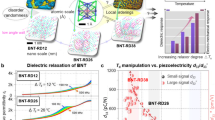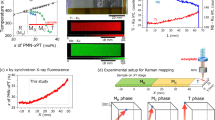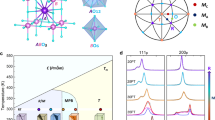Abstract
Understanding the evolution and role of nanoscale polar structures during polarization rotation in relaxor ferroelectrics is a long-standing challenge in materials science and condensed-matter physics. These nanoscale polar structures are characterized by polar nanodomains, which are believed to play a key role in enabling the large susceptibilities of relaxors. Using epitaxial strain, we stabilize the intermediate step during polarization rotation in epitaxial films of a prototypical relaxor and study the co-evolution of polarization and polar nanodomains. Our multimodal approach allows for a detailed examination of correlations between polarization and polar nanodomains; illuminates the effect of local chemistry, strain and electric field on their co-evolution; and reveals the underappreciated role of strain in enabling the large electromechanical coupling in relaxors. As the strain increases, the competition between chemistry-driven disorder and strain-driven order of the polar units intensifies, which is manifested in the coexistence of inclined and elongated polar nanodomains in the intermediate step of polarization rotation. Our findings establish that structural transitions between polar nanodomain configurations underpins the polarization rotation and large electromechanical coupling of relaxors.
This is a preview of subscription content, access via your institution
Access options
Access Nature and 54 other Nature Portfolio journals
Get Nature+, our best-value online-access subscription
$29.99 / 30 days
cancel any time
Subscribe to this journal
Receive 12 print issues and online access
$209.00 per year
only $17.42 per issue
Buy this article
- Purchase on Springer Link
- Instant access to full article PDF
Prices may be subject to local taxes which are calculated during checkout




Similar content being viewed by others
Data availability
All data supporting the findings of this study are available within the Article and its Supplementary Information. Additional data are available from the corresponding author upon request. Source data are provided with this paper.
Code availability
Custom Python scripts used to analyse the STEM images are available from the corresponding author upon request.
References
Park, S.-E. & Shrout, T. R. Ultrahigh strain and piezoelectric behavior in relaxor based ferroelectric single crystals. J. Appl. Phys. 82, 1804–1811 (1997).
Fu, H. & Cohen, R. E. Polarization rotation mechanism for ultrahigh electromechanical response in single-crystal piezoelectrics. Nature 403, 281–283 (2000).
Bai, F. et al. X-ray and neutron diffraction investigations of the structural phase transformation sequence under electric field in 0.7Pb(Mg1/3Nb2/3)-0.3PbTiO3 crystal. J. Appl. Phys. 96, 1620–1627 (2004).
Kutnjak, Z., Petzelt, J. & Blinc, R. The giant electromechanical response in ferroelectric relaxors as a critical phenomenon. Nature 441, 956–959 (2006).
Noheda, B. et al. Polarization rotation via a monoclinic phase in the piezoelectric 92% PbZn1/3Nb2/3O3-8% PbTiO3. Phys. Rev. Lett. 86, 3891–3894 (2001).
Wall, S. et al. Ultrafast disordering of vanadium dimers in photoexcited VO2. Science 362, 572–576 (2018).
Xu, G., Wen, J., Stock, C. & Gehring, P. M. Phase instability induced by polar nanoregions in a relaxor ferroelectric system. Nat. Mater. 7, 562–566 (2008).
Li, F. et al. The origin of ultrahigh piezoelectricity in relaxor-ferroelectric solid solution crystals. Nat. Commun. 7, 13807 (2016).
Jin, Y. M., Wang, Y. U., Khachaturyan, A. G., Li, J. F. & Viehland, D. Adaptive ferroelectric states in systems with low domain wall energy: tetragonal microdomains. J. Appl. Phys. 94, 3629–3640 (2003).
Otoničar, M. et al. Connecting the multiscale structure with macroscopic response of relaxor ferroelectrics. Adv. Funct. Mater. 30, 2006823 (2020).
Manley, M., Lynn, J., Abernathy, D. & Specht, E. Phonon localization drives polar nanoregions in a relaxor ferroelectric. Nat. Commun. 5, 3683 (2013).
Manley, M. E. et al. Giant electromechanical coupling of relaxor ferroelectrics controlled by polar nanoregion vibrations. Sci. Adv. 2, e1501814 (2015).
Yang, Y. et al. Morphotropic relaxor boundary in a relaxor system showing enhancement of electrostrain and dielectric permittivity. Phys. Rev. Lett. 123, 137601 (2019).
Welberry, T. R. Diffuse scattering and Monte Carlo studies of relaxor ferroelectrics. Metall. Mater. Trans. 39, 3170–3178 (2008).
Goossens, D. Diffuse scattering from lead-containing ferroelectric perovskite oxides. ISRN Mater. Sci. 2013, 107178 (2013).
Bosak, A., Chernyshov, D., Vakhrushev, S. & Krisch, M. Diffuse scattering in relaxor ferroelectrics: true three-dimensional mapping, experimental artefacts and modelling. Acta Crystallogr. A Found. Adv. 68, 117–123 (2012).
Paściak, M., Wołcyrz, M. & Pietraszko, A. Interpretation of the diffuse scattering in Pb-based relaxor ferroelectrics in terms of three-dimensional nanodomains of the 〈110〉-directed relative interdomain atomic shifts. Phys. Rev. B 76, 014117 (2007).
Kim, J. et al. Epitaxial strain control of relaxor ferroelectric phase evolution. Adv. Mater. 31, 1901060 (2019).
Xu, G., Zhong, Z., Hiraka, H. & Shirane, G. Three-dimensional mapping of diffuse scattering in Pb(Zn1/3Nb2/3)O3-xPbTiO3. Phys. Rev. B 70, 174109 (2004).
Takenaka, H., Grinberg, I., Liu, S. & Rappe, A. M. Slush-like polar structures in single-crystal relaxors. Nature 546, 391–395 (2017).
Krogstad, M. J. et al. The relation of local order to material properties in relaxor ferroelectrics. Nat. Mater. 17, 718–724 (2018).
Davis, M., Damjanovic, D. & Setter, N. Electric-field-, temperature-, and stress-induced phase transitions in relaxor ferroelectric single crystals. Phys. Rev. B 73, 014115 (2006).
Sato, Y., Hirayama, T. & Ikuhara, Y. Real-time direct observations of polarization reversal in a piezoelectric crystal: Pb(Mg1/3Nb2/3)O3-PbTiO3 studied via in situ electrical biasing transmission electron microscopy. Phys. Rev. Lett. 107, 187601 (2011).
Kumar, A. et al. Atomic-resolution electron microscopy of nanoscale local structure in lead-based relaxor ferroelectrics. Nat. Mater. 20, 62–67 (2021).
Kim, J. et al. Frequency-dependent suppression of field-induced polarization rotation in relaxor ferroelectric thin films. Matter 4, 2367–2377 (2021).
Guo, R. et al. Origin of the high piezoelectric response in PbZr1−xTixO3. Phys. Rev. Lett. 84, 5423–5426 (2000).
Davis, M. Picturing the elephant: giant piezoelectric activity and the monoclinic phases of relaxor-ferroelectric single crystals. J. Electroceram. 19, 25–47 (2007).
Ohwada, K. et al. Neutron diffraction study of the irreversible R–MA–MC phase transition in single crystal Pb[(Zn1/3Nb2/3)1–xTix]O3. J. Phys. Soc. Jpn 70, 2778–2783 (2001).
Wen, J., Xu, G., Stock, C. & Gehring, P. M. Response of polar nanoregions in 68%Pb(Mg1/3Nb2/3)O3-32%PbTiO3 to a [001] electric field. Appl. Phys. Lett. 93, 082901 (2008).
Prosandeev, S., Wang, D. & Bellaiche, L. Properties of epitaxial films made of relaxor ferroelectrics. Phys. Rev. Lett. 111, 247602 (2013).
Li, F., Zhang, S., Damjanovic, D., Chen, L. & Shrout, T. R. Local structural heterogeneity and electromechanical responses of ferroelectrics: learning from relaxor ferroelectrics. Adv. Funct. Mater. 28, 1801504 (2018).
Nahas, Y. et al. Inverse transition of labyrinthine domain patterns in ferroelectric thin films. Nature 577, 47–51 (2020).
Kisi, E. H., Piltz, R. O., Forrester, J. S. & Howard, C. J. The giant piezoelectric effect: electric field induced monoclinic phase or piezoelectric distortion of the rhombohedral parent? J. Phys. Condens. Matter 15, 3631 (2003).
Janolin, P.-E., Dkhil, B., Davis, M., Damjanovic, D. & Setter, N. Uniaxial-stress induced phase transitions in [001]C-poled 0.955Pb(Zn1/3Nb2/3)O3–0.045PbTiO3. Appl. Phys. Lett. 90, 152907 (2007).
Li, F. et al. Giant piezoelectricity of Sm-doped Pb(Mg1/3Nb2/3)O3-PbTiO3 single crystals. Science 364, 264–268 (2019).
Matsuura, M. et al. Composition dependence of the diffuse scattering in the relaxor ferroelectric compound (1−x)Pb(Mg1/3Nb2/3)O3−xPbTiO3(0 ≤ x ≤ 0.40). Phys. Rev. B 74, 144107 (2006).
Paull, O. et al. Anisotropic epitaxial stabilization of a low-symmetry ferroelectric with enhanced electromechanical response. Nat. Mater. 21, 74–80 (2021).
Sang, X. & LeBeau, J. M. Revolving scanning transmission electron microscopy: correcting sample drift distortion without prior knowledge. Ultramicroscopy 138, 28–35 (2014).
LeBeau, J. M., Findlay, S. D., Allen, L. J. & Stemmer, S. Position averaged convergent beam electron diffraction: theory and applications. Ultramicroscopy 110, 118–125 (2010).
Acknowledgements
J.K. acknowledges support from the Army Research Office under grant W911NF-21-1-0118. J.M.L. and A.K. acknowledge support for this work from the John Chipman Career Development Professorship and the NVIDIA Corporation for supplying a Titan Xp graphics processing unit for STEM image simulations. A.F. acknowledges support from the National Science Foundation under grant DMR-2102895. Z.T. acknowledges support from the Army Research Office under grant W911NF-21-1-0126. A.M.R. acknowledges support from the Office of Naval Research under grant N00014-20-1-2701. Y.Q. acknowledges the center for 3D Ferroelectric Microelectronics (3DFeM), an Energy Frontier Research Center funded by the US Department of Energy (DOE), Office of Science, Basic Energy Sciences under Award No. DE-SC0021118, including the extension of bond-valence molecular dynamics modeling to thin films. Y.Q., H.T., A.M.R., J.M.L. and L.W.M. also acknowledge support from the Army Research Laboratory via the Collaborative for Hierarchical Agile and Responsive Materials (CHARM) under cooperative agreement W911NF-19-2-0119. Use of the Advanced Photon Source, an Office of Science User Facility operated for the US Department of Energy (DOE), Office of Science, by Argonne National Laboratory (ANL), was supported by the US DOE under contract no. DE-AC02-06CH11357. The authors acknowledge computational support from the High-Performance Computing Modernization Office (HPCMO) of the US Department of Defense (DOD) and National Energy Research Scientific Computing Center (NERSC), a US Department of Energy, Office of Science User Facility located at Lawrence Berkeley National Laboratory, operated under Contract No. DE-AC02-05CH11231. This work was performed in part at the Center for Nanoscale Systems (CNS), a member of the National Nanotechnology Infrastructure Network (NNIN) and part of Harvard University, supported by the National Science Foundation under award no. ECS-0335765. This work was performed in part in the MIT.nano Characterization Facilities.
Author information
Authors and Affiliations
Contributions
J.K. and L.W.M. conceived this study. J.K. synthesized the films and performed the structural characterizations. J.K., A.F. and Z.T. fabricated the devices for in operando synchrotron diffraction. J.K. and D.M. performed the synchrotron diffraction measurements. A.K. and J.M.L. performed the STEM studies. Y.Q., H.T. and A.M.R. performed the molecular dynamics simulation studies. P.J.R. and J.-W.K. developed the in operando synchrotron diffraction setup. J.K., D.M., Z.T., P.J.R. and J.-W.K. performed the in operando synchrotron diffraction measurements. J.K. and A.K. wrote the initial draft of the manuscript. J.K., A.K., Y.Q., H.T., A.M.R., J.M.L. and L.W.M. revised the manuscript. All the authors discussed the results and edited the manuscript.
Corresponding author
Ethics declarations
Competing interests
The authors declare no competing interests.
Peer review
Peer review information
Nature Physics thanks Dawei Wang and the other, anonymous, reviewer(s) for their contribution to the peer review of this work.
Additional information
Publisher’s note Springer Nature remains neutral with regard to jurisdictional claims in published maps and institutional affiliations.
Supplementary information
Supplementary Information
Supplementary Figs. 1–9 and refs. 1–4.
Source data
Source Data Fig. 3
Electric-field-dependent XRD data.
Source Data Fig. 4
XRD fitting results and electric-field-dependent XRD data.
Rights and permissions
Springer Nature or its licensor holds exclusive rights to this article under a publishing agreement with the author(s) or other rightsholder(s); author self-archiving of the accepted manuscript version of this article is solely governed by the terms of such publishing agreement and applicable law.
About this article
Cite this article
Kim, J., Kumar, A., Qi, Y. et al. Coupled polarization and nanodomain evolution underpins large electromechanical responses in relaxors. Nat. Phys. 18, 1502–1509 (2022). https://doi.org/10.1038/s41567-022-01773-y
Received:
Accepted:
Published:
Issue Date:
DOI: https://doi.org/10.1038/s41567-022-01773-y
This article is cited by
-
An entropy tactic
Nature Energy (2023)



